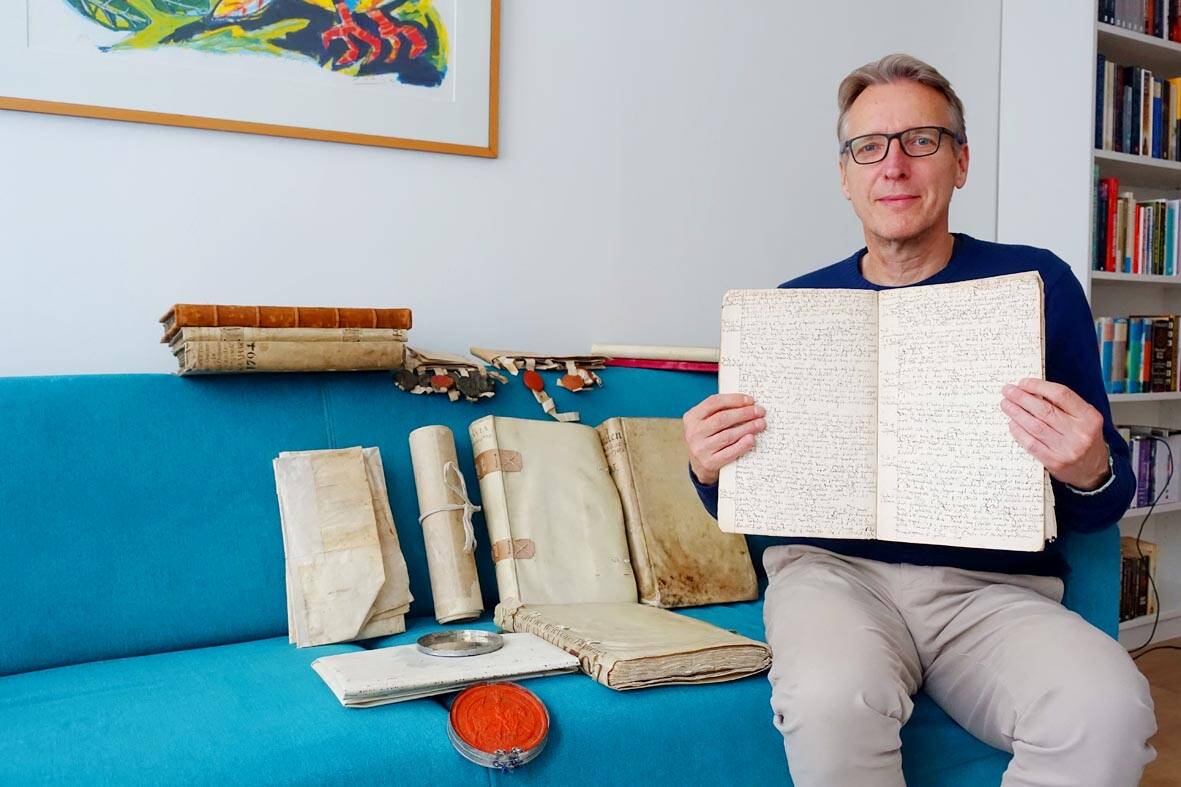A Dutch art sleuth has recovered a priceless trove of stolen documents from the 15th to the 19th century, including several UNESCO-listed archives from the world’s first multinational corporation.
Arthur Brand, nicknamed the “Indiana Jones of the Art World” for his high-profile recovery of stolen masterpieces, said the latest discovery was among his most significant.
“In my career, I have been able to return fantastic stolen art, from Picassos to a Van Gogh... yet this find is one of the highlights of my career,” Brand said.

Photo: AFP
Many of the documents recount the early days of the Dutch East India Company (VOC), whose globetrotting trading and military operations contributed to the Dutch “Golden Age,” when the Netherlands was a global superpower.
The 17th century VOC documents contain a “fascinating glimpse into the events of that time in places like Europe, India, Indonesia, South Africa and Latin America,” Brand said.
One document from 1602 recounts the first meeting of the VOC, during which its famous logo — considered the world’s first corporate logo — was designed.
VOC merchants criss-crossed the globe, catapulting the Netherlands to a world trading power but also exploiting and oppressing the colonies it conquered, including Taiwan.
The company was also a leading diplomatic power and one document relates a visit in 1700 by top VOC officials to the court of the Mughal emperor in India.
“Since the Netherlands was one of the most powerful players in the world at that time in terms of military, trade, shipping and colonies, these documents are part of world history,” Brand said.
UNESCO agrees, designating the VOC archives as part of its “Memory of the World” documentary heritage collection.
“The VOC archives make up the most complete and extensive source on early modern world history anywhere,” says UNESCO on its Web site.
The trove also featured early ships logs from one of the world’s most famous admirals, Michiel de Ruyter, whose exploits are studied in naval academies even today.
De Ruyter gained fame for his daring 1667 raid to attack the English fleet in the River Medway, one of the greatest humiliations in world naval history.
The ship’s logs, written in his own hand, relate the admiral’s first experience of naval warfare, the 1641 Battle of St Vincent against the Spanish fleet.
No less enthralling is the “who-dunnit” of how Brand came by the documents.
Brand received an E-mail from someone who had stumbled across a box of seemingly ancient manuscripts while clearing out the attic of an incapacitated family member. This family member occasionally lent money to a friend, who would leave something as collateral — in this case the box of documents.
“I received some photos and couldn’t believe my eyes. This was indeed an extraordinary treasure,” Brand said.
Brand investigated with Dutch police and concluded the documents had been stolen in 2015 from the vast National Archives in The Hague.
The main suspect — an employee at the archives who had indeed left the box as collateral but never picked it up — has since died.
Brand compared the theft to a daring heist by a curator at the British Museum, who spirited away some 1,800 objects, selling some of them on eBay.
The art detective said he spent many an evening sifting through the documents, transported back in time.
“Wars at sea, negotiations at imperial courts, distant journeys to barely explored regions, and knights,” he said.
“I felt like I had stepped into Robert Louis Stevenson’s ‘Treasure Island.”

Most heroes are remembered for the battles they fought. Taiwan’s Black Bat Squadron is remembered for flying into Chinese airspace 838 times between 1953 and 1967, and for the 148 men whose sacrifice bought the intelligence that kept Taiwan secure. Two-thirds of the squadron died carrying out missions most people wouldn’t learn about for another 40 years. The squadron lost 15 aircraft and 148 crew members over those 14 years, making it the deadliest unit in Taiwan’s military history by casualty rate. They flew at night, often at low altitudes, straight into some of the most heavily defended airspace in Asia.

Many people in Taiwan first learned about universal basic income (UBI) — the idea that the government should provide regular, no-strings-attached payments to each citizen — in 2019. While seeking the Democratic nomination for the 2020 US presidential election, Andrew Yang, a politician of Taiwanese descent, said that, if elected, he’d institute a UBI of US$1,000 per month to “get the economic boot off of people’s throats, allowing them to lift their heads up, breathe, and get excited for the future.” His campaign petered out, but the concept of UBI hasn’t gone away. Throughout the industrialized world, there are fears that

Like much in the world today, theater has experienced major disruptions over the six years since COVID-19. The pandemic, the war in Ukraine and social media have created a new normal of geopolitical and information uncertainty, and the performing arts are not immune to these effects. “Ten years ago people wanted to come to the theater to engage with important issues, but now the Internet allows them to engage with those issues powerfully and immediately,” said Faith Tan, programming director of the Esplanade in Singapore, speaking last week in Japan. “One reaction to unpredictability has been a renewed emphasis on

Taiwan’s democracy is at risk. Be very alarmed. This is not a drill. The current constitutional crisis progressed slowly, then suddenly. Political tensions, partisan hostility and emotions are all running high right when cool heads and calm negotiation are most needed. Oxford defines brinkmanship as: “The art or practice of pursuing a dangerous policy to the limits of safety before stopping, especially in politics.” It says the term comes from a quote from a 1956 Cold War interview with then-American Secretary of State John Foster Dulles, when he said: ‘The ability to get to the verge without getting into the war is